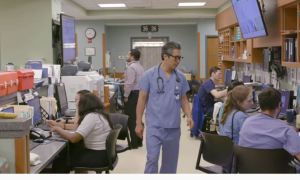
Tag Archives: Hospitals
Hospital Care: How Improved Design Of Emergency Rooms Can Save Lives (Video)
 Produced by WIRED Brand Lab with American Institute of Architects | How can design transform emergency rooms from one of the most stressful and chaotic places into a place of healing? Dr. Bon Ku and architect Billie Faircloth, AIA, break down the science behind designing a better work environment for hospitals.
Produced by WIRED Brand Lab with American Institute of Architects | How can design transform emergency rooms from one of the most stressful and chaotic places into a place of healing? Dr. Bon Ku and architect Billie Faircloth, AIA, break down the science behind designing a better work environment for hospitals.
Medical Technology: “TeleNeurology” Remote Consultations Are As Effective As Office Visits
From a Becker’s Hospital Review online release:
 Telemedicine extends care accessibility to people with epilepsy, who may be unable to drive to appointments, as well as people with mobility issues stemming from neurologic disorders such as multiple sclerosis. Virtual care also helps address geographic barriers by allowing patients in rural areas to see a neurologist through telemedicine technology instead of having to travel hours for in-person care, said lead author Jaime Hatcher-Martin, MD, PhD, a member of AAN, according to the news release.
Telemedicine extends care accessibility to people with epilepsy, who may be unable to drive to appointments, as well as people with mobility issues stemming from neurologic disorders such as multiple sclerosis. Virtual care also helps address geographic barriers by allowing patients in rural areas to see a neurologist through telemedicine technology instead of having to travel hours for in-person care, said lead author Jaime Hatcher-Martin, MD, PhD, a member of AAN, according to the news release.

The studies’ analysis found that patients and their caregivers were equally satisfied with virtual physician visits and in-person appointments. Some studies showed that the use of telemedicine is as effective as in-person care to make accurate diagnoses. However, the researchers noted that there have been few randomized, controlled studies on telemedicine for neurology apart from stroke care.
Healthcare Podcasts: “Will New Hospital Price Transparency Rules Help You?”(HealthAffairs.org)
 In a WTOP-FM interview, Health Affairs Editor-In-Chief Alan Weil assesses how consumers may (or may not) benefit from two long-anticipated rules, recently unveiled by the Trump Administration, that increase price transparency for both hospitals and insurers.
In a WTOP-FM interview, Health Affairs Editor-In-Chief Alan Weil assesses how consumers may (or may not) benefit from two long-anticipated rules, recently unveiled by the Trump Administration, that increase price transparency for both hospitals and insurers.
Emergency Medicine: When “Treating Everyone” Meets “Triage”, Patients And Healthcare Must Wait
From a STAT online article:
 The specialty of emergency medicine is firmly grounded in social justice and providing access to expert care to everyone who comes in. That means treating anyone, with any condition, at any time. And yet, embedded into emergency department operations is a system that might be perceived as unjust: the concept of triage. The emergency queue isn’t “first come, first served.” It’s nonlinear by design, since triage prioritizes the severity of illness. The severely ill or injured receive immediate attention. Everyone else, to various degrees, must wait.
The specialty of emergency medicine is firmly grounded in social justice and providing access to expert care to everyone who comes in. That means treating anyone, with any condition, at any time. And yet, embedded into emergency department operations is a system that might be perceived as unjust: the concept of triage. The emergency queue isn’t “first come, first served.” It’s nonlinear by design, since triage prioritizes the severity of illness. The severely ill or injured receive immediate attention. Everyone else, to various degrees, must wait.
There are situations when waiting feels immoral to me, not merely inconvenient. Being an emergency doctor means shouldering burdens for perceived injustices that we have little, if any, control over. Most of the beds were locked up with patients boarding in the ED, which means they are waiting for an inpatient bed to become available in the hospital.
Hospitals have high expectations regarding how quickly patients are seen in the emergency department, and my colleagues and I share that goal. But there’s less urgency when it comes to discharging patients from the hospital, which would unclog the backup in the emergency department — and its waiting room.
Healthcare Surveys: Nursing Shortage Threatens System As Baby Boomers & Nurses Retire
From a Healthcare Finance news article:
 A third of the nurses who took the survey are baby boomers and 20% of survey takers said they planned to retire in the next five years. More than a quarter, 27%, said they were unlikely to be working at their current job in a year.
A third of the nurses who took the survey are baby boomers and 20% of survey takers said they planned to retire in the next five years. More than a quarter, 27%, said they were unlikely to be working at their current job in a year.
The shortage threatens to collide with the impending retirement of the baby boomers, all of whom will be 65 years old by 2030, said the survey titled “A Challenging Decade Ahead.” People over 65 are hospitalized three times as often as middle-aged individuals, according to the Center for Disease Control and Prevention.
Amid a nursing shortage, hospitals are struggling to hire and keep nurses, with burnout and workplace violence cited as contributing factors, according to a new survey.
Flexibility and work-life balance had the most influence for 39% of nurses in whether they decided to stick with a job, though 31% say compensation and benefits were the biggest driving factor, according to AMN Healthcare’s 2019 Survey of Registered Nurses.
To read more: https://www.healthcarefinancenews.com/node/139458
Medical Podcasts: New Stanford Hospital Uses Technology To Stay “Future-Proofed”
From a Stanford Medicine online article:
 “A simple example would be copper and fiber wires. When you’re putting wires in a new facility, it’s easier to put in many more than you need that moment because putting them in 5 years from now or 10 years from now is quite hard. Something like 85 percent of our copper wires and fiber optic cables are dark right now because we know we’re going to need them in the future.”
“A simple example would be copper and fiber wires. When you’re putting wires in a new facility, it’s easier to put in many more than you need that moment because putting them in 5 years from now or 10 years from now is quite hard. Something like 85 percent of our copper wires and fiber optic cables are dark right now because we know we’re going to need them in the future.”
When you consider the fast pace of technological advances today, you wonder how do you go about building a new hospital and keep the technology relevant for 10, 20 or even 50 years? I put that question to Stanford Health Care’s technology wiz Gary Fritz. He told me:
“We try to do something we call future-proof the hospital. We tried to make design decisions and technology decisions that allow us to move to the current or the next generation technology as easily as possible.”
Health Care System: Life-Saving Drug Shortages At U.S. Hospitals Reach “Unfathomable” Levels
From a Becker’s Hospital Review online release:
 “This is the fourth time in the last two years we’ve had to activate our hospital’s emergency operations plan for a major drug shortage,” Dr. Biddinger told NBC News. “It’s almost unfathomable in modern medicine. I never thought we would get to a point in the U.S. healthcare system where we wouldn’t have essential medicines to be able to treat patients.”
“This is the fourth time in the last two years we’ve had to activate our hospital’s emergency operations plan for a major drug shortage,” Dr. Biddinger told NBC News. “It’s almost unfathomable in modern medicine. I never thought we would get to a point in the U.S. healthcare system where we wouldn’t have essential medicines to be able to treat patients.”
Drug shortages are increasing and lasting longer, according to an FDA report published Oct. 29. Of 163 drugs running low in 2013-17, over 62 percent were due to manufacturing or product quality problems.
Hospitals nationwide are facing shortages of crucial, lifesaving drugs, with 116 drugs currently running low, according to the FDA and cited by NBC News.
Boston-based Massachusetts General Hospital is a prime example, getting as close as two weeks away from canceling a lifesaving cardiac surgery due to a lack of herapin, a blood-thinner, according to Paul Biddinger, MD, chief of the division of emergency preparedness at Massachusetts General Hospital.
Drug Reviews: Top Ten Antiobiotics Used For Patients In Hospital ER’s
From a Becker’s Hospital Review online release:
Ceftriaxone and azithromycin are the top two most commonly administered antibiotics in U.S. emergency rooms for patients who are not admitted to the hospital, according to a study published in the American Journal of Health-System Pharmacy.
 The top 10 most commonly administered antibiotics in the ER for nonadmitted patients were:
The top 10 most commonly administered antibiotics in the ER for nonadmitted patients were:
• ceftriaxone: 30.6 percent
• azithromycin: 10.8 percent
• clindamycin: 6.6 percent
• levofloxacin: 5.8 percent
• cephalexin: 5.3 percent
• metronidazole: 4.5 percent
• sulfamethoxazole-trimethoprim: 4.2 percent
• ciprofloxacin: 3.9 percent
• amoxicillin: 3.8 percent
• penicillin: 3.3 percent
The researchers also found that most common emergency room diagnoses were urinary tract infections and cellulitis, and that prescribing practices generally aligned with treatment guidelines for these diagnoses.
Health: Asymptomatic Bacteriuria Diagnosis In Older Patients Should Not Require Antibiotics
From a New York Times online article:
 At Dr. Soong’s hospital, withholding the results of urine cultures, unless doctors actually called the microbiology lab to request them, reduced prescriptions for asymptomatic bacteriuria to 12 percent from 48 percent of non-catheterized patients, with no loss of safety.
At Dr. Soong’s hospital, withholding the results of urine cultures, unless doctors actually called the microbiology lab to request them, reduced prescriptions for asymptomatic bacteriuria to 12 percent from 48 percent of non-catheterized patients, with no loss of safety.
“The extra step of having the clinician call eliminated a lot of frivolous testing,” Dr. Soong said.
In patients who have none of the typical symptoms of a urinary tract infection — no painful or frequent urination, no blood in the urine, no fever or lower abdominal tenderness — lab results detecting bacteria in the urine don’t indicate infection and thus shouldn’t trigger treatment.
Older people, and nursing home residents in particular, often have urinary systems colonized by bacteria; they will have a positive urine test almost every time, but they’re not sick.
To read more: https://www.nytimes.com/2019/10/14/health/urine-tests-elderly.html









